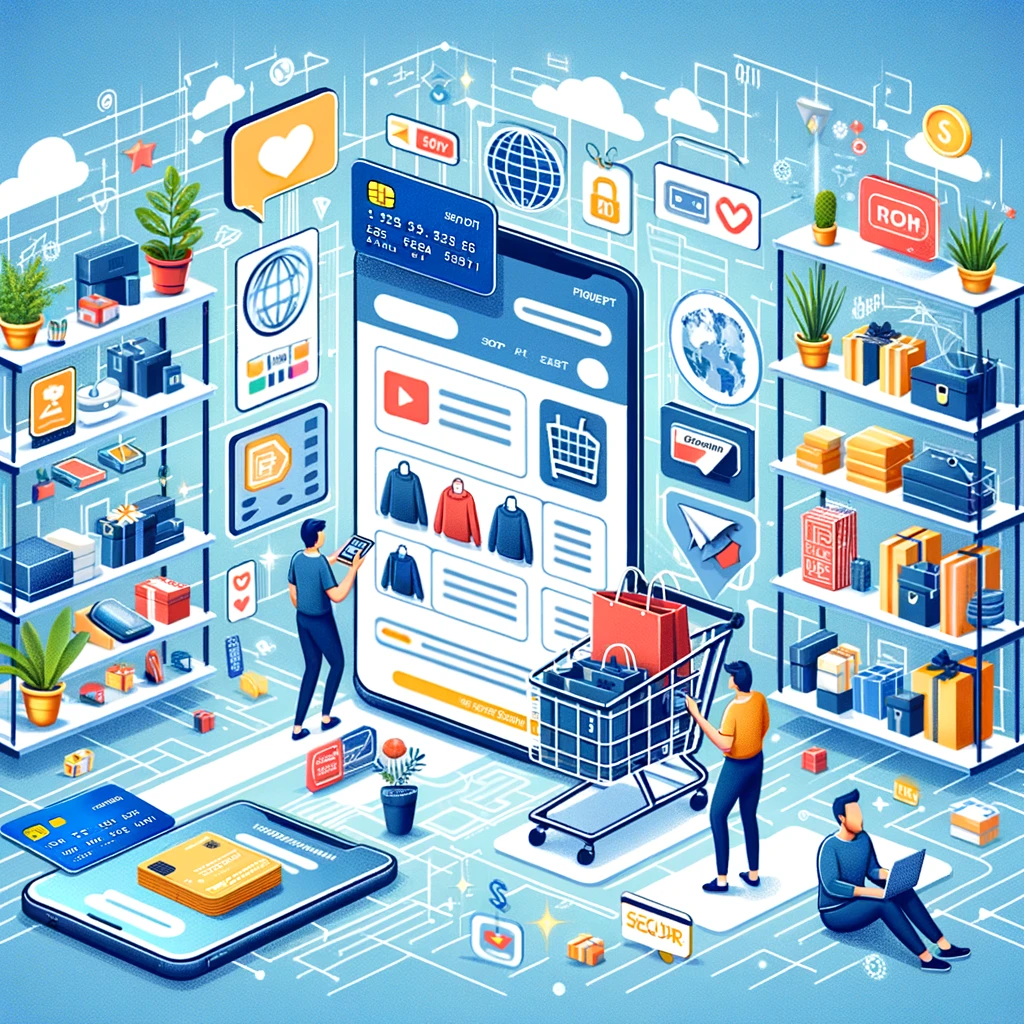What is E-commerce, and how you can start your e-commerce business today?
Over the last decade, e-commerce, or “electronic-commerce” has surged as an avenue for startups, small businesses, and multinational corporations to sell to customers around the world. In 2024 E-commerce will share 20.8% of all retail markets and sales are expected to surpass $8.1 trillion by 2026.
So how does it work?
Through personal devices, consumers can access virtual marketplaces to explore and purchase products and services. Once an order is initiated, a complex digital interaction begins. The customer’s browser communicates with the e-commerce site’s server, transmitting order details. This information is then routed to an order management system. From there, it’s dispersed to various databases responsible for tracking inventory and processing payments through systems like PayPal or other banking systems. This intricate process verifies both the availability of the items and the customer’s ability to pay, ensuring a seamless transaction.
Phew! Now that we got the technical side out of the way, it’s time to learn how e-commerce can apply to your business.
E-commerce websites
E-commerce websites serve as digital storefronts in the online marketplace, bridging the gap between buyers and sellers. Like physical shelves, these virtual platforms are where products are displayed. It is almost as if your customers are visiting the store. Your website should function not only as the showcase for goods but also as the salesperson at the end of the transaction endpoint, and most companies have a strategy that allows them to drive sales through their checkout page.
E-commerce Businesses Models

E-commerce comes in many different shapes and sizes. Depending on your specific business needs, one business model may work better than the other. We laid out 8 common e-commerce business models.
- Business to Business (B2B): This model involves transactions between businesses, such as the exchange of products, services, or information.
- Business to Consumer (B2C): Here, businesses sell directly to consumers. This model often involves intermediaries for shipping and customer service.
- Direct-to-Consumer (D2C): In contrast to B2C, D2C involves businesses selling directly to consumers online without intermediaries or distributors.
- Consumer to Consumer (C2C): This type of e-commerce enables consumers to trade products, services, and information with each other online. Platforms like eBay and Craigslist facilitate these transactions.
- Consumer to Business (C2B): This inverse of the traditional B2C model sees consumers offering products and services online for businesses to bid on and purchase. Platforms like iStock, which sells royalty-free images, are an example of this model.
- Business to Administration (B2A): This model covers online transactions between companies and public administration or government bodies. It includes a wide range of e-services, such as legal documents, Social Security, and other data.
- Consumer to Administration (C2A): Here, individuals engage in online transactions with government bodies. This includes a range of activities, from Social Security and tax payments to health service interactions.
- Mobile Commerce (M-commerce): This refers to sales transactions conducted through mobile devices, encompassing mobile shopping, banking, and payments, sometimes facilitated by mobile chatbots.
There are many business models when it comes to e-commerce, so make sure you are strategic in choosing the one (or few) that suit your business needs.
E-commerce platforms (benefits and challenges)
Like with business models, there are also different types of e-commerce platforms.
These platforms can be broadly categorized into 4 types, each with its unique features, benefits, and challenges.
- Online Marketplaces: Platforms like Amazon, eBay, and Etsy fall under this category. They are user-friendly, and make it easy for the business to start selling their product as soon as possible.
- Benefits: They offer built-in customer traffic and discovery features, reducing the need for active marketing efforts from the business.
- Challenges: Because there are so many sellers, the ability to build a distinct brand identity is limited. Also, sellers don’t usually own customer data.
- SaaS (Software as a Service) Platforms: Examples include Shopify, BigCommerce, and Salesforce Commerce Cloud. These platforms host your online store in the cloud, eliminating the need for in-house development or infrastructure.
- Benefits: They provide comprehensive tools for website building, product listing, and payment processing.
- Challenges: Because your shop is not in a marketplace, driving traffic and sales requires your marketing efforts.
- Open Source Platforms: Platforms like WooCommerce or Magento (Adobe Commerce) are open-source platforms whose source code is freely available for modification and enhancement by anyone
- Benefits: High customizability and control over the online store.
- Challenges: Requires significant IT resources for development and maintenance.
- Social Selling Channels: Platforms like Facebook, Instagram, and now TikTok offer in-platform buying and selling features, allowing direct sales to audiences without a traditional online storefront.
- Benefits: Easy access to existing audiences on managed channels, without building a separate e-commerce website.
- Challenges: The audience and customer data are not owned by the seller. Also, as a seller, you are subject to the rules and restrictions of each platform
Almost there! But, you need to consider a few more things before starting your e-commerce business. Here are some advantages and disadvantages of e-commerce as a business.
Advantages of E-commerce
E-commerce offers a range of advantages for both businesses and consumers, making it an increasingly popular sales method. Understanding these benefits can help determine if e-commerce aligns with your business goals and audience. Here are 5 key advantages:
- Rapid Growth:
- E-commerce is expanding swiftly. For instance, U.S. small- and medium-sized businesses on Amazon saw over $265 billion in e-commerce sales in the Q3 of 2022 alone.
- Global Marketing Reach:
- Unlike traditional brick-and-mortar stores, e-commerce is not restricted by geographic boundaries.
- Ease of Ordering Products:
- E-commerce platforms offer customers the convenience of browsing and purchasing products online from anywhere, at any time.
- Lower Operating Costs:
- Running an e-commerce business typically incurs lower costs compared to physical stores. This includes savings on retail space, employee salaries, and building maintenance. Additionally, businesses can operate 24/7 online.
- Direct-to-Consumer Access: E-commerce enables direct interaction and relationship-building with consumers, therefore, businesses can tailor their marketing and offer to specific customer needs.
Disadvantages of E-commerce
E-commerce, despite its numerous advantages, also presents several challenges that businesses should be aware of. It is crucial to understand these challenges if you are considering or currently running an e-commerce business. Let’s dive into 5 of these challenges:
- Limited Face-to-Face Interaction:
- Some businesses rely on personal interaction to make sales. In e-commerce, this aspect is missing, which might affect certain products or services that require a more personal touch.
- Technology:
- E-commerce is heavily dependent on technology, therefore technical issues like website downtime or payment gateway failures can impact sales. Also, the risk of data breaches and cyber-attacks is a significant concern in e-commerce.
- Shipping and Fulfillment at Scale:
- As a business grows, managing inventory and fulfilling orders efficiently can become challenging. Unlike physical stores where customers leave with the product, e-commerce involves a wait time for product delivery.
- Increased Competition:
- The e-commerce space is highly competitive, with many businesses competing for the same market share.
- Returns and Customer Service Demands:
- E-commerce businesses must have effective return policies and customer service to handle inquiries and complaints.
Steps to Starting an E-commerce Business

Ok, so with all that in mind, are you sure that e-commerce is the best direction for your business? If your answer is yes, here are 5 things you should incorporate into your e-commerce business.
- Great Products:
- Your e-commerce business’s heart lies in offering high-quality, reliable products or services. These should address an unmet need or challenge for your customers and be priced competitively.
- A Compelling Brand Story:
- A unique brand identity is more than just a great product. It involves conveying your business’s purpose, vision, and the value your products bring to customers’ lives.
- A Focus on the Customer:
- Define your target audience and direct your marketing efforts to attract loyal and enthusiastic customers who resonate with your brand story.
- A Smooth Online Experience:
- The user experience of your online store should be intuitive and user-friendly. A well-designed website makes the purchasing process effortless.
- Timely Order Fulfillment:
- Efficiency and promptness in delivery are crucial in e-commerce. Customers expect their purchases to be delivered intact and on time. Ensure sufficient inventory, especially during peak seasons, to meet customer demands.
Start today!
The e-commerce sector offers ample opportunities for newcomers eager to introduce fresh, innovative ideas into the international market. With retail e-commerce sales on the rise, this business model presents a perfect starting point for budding entrepreneurs.
If you’re gearing up to launch an e-commerce venture, keep this guide as a valuable reference to consult throughout your journey.












